Optimization of Uplift Piles for a Base Plate Considering Local Anti-Floating Stability
Abstract
:1. Introduction
2. Optimization Method
2.1. Problem Description
2.2. Design Variable and Sensitivity Coefficient
2.3. BESO Process
3. Verification Analysis
3.1. Numerical Models
3.2. Variation of Total Strain Energy and Maximum Differential Deformation
3.3. The Pile Length Distribution
3.4. Analysis
4. Case Study
5. Conclusions
- When the uplift piles for the base plate adopts large pile diameter and sparse spacing, the initial deformation degree of the base plate is large. The BESO process can greatly reduce the maximum differential deformation and total strain energy of the base plate. After optimization, the dispersion degree of pile lengths distribution is large.
- When the uplift piles for the base plate adopts small pile diameter and dense spacing, the initial deformation degree of the base plate is small. During the optimization process, the maximum differential deformation and total strain energy are small and oscillated. After optimization, the pile lengths are close.
- To consider the local anti-floating stability of the base plate, the uplift piles should be preferably designed with small pile diameters, dense spacing, and equal pile lengths. If only the design of large pile diameter and sparse spacing can be adopted, long piles should be arranged at the center area of the base plate; short piles should be arranged at the edge area and under the column loads. The length ratio of the short piles to the long piles should be about 0.4~0.6.
- The deformation degree of the base plate of optimization design 1 (large pile diameter and sparse spacing, unequal pile lengths) and optimization design 2 (small pile diameter and dense spacing, equal pile lengths) are significantly lower than the original design. It proves that the two optimization designs can effectively increase the local anti-floating stability for the base plate.
- In the numerical calculation related to the pile resistance, if the model has a large area of the base plate and a large number of piles, in order to improve the computational efficiency, the solid unit of the pile has to be replaced by the built-in pile unit in the numerical software, and it is still necessary to study and develop the topology optimization methods and procedures applicable to the pile unit, so as to promote the application in the actual engineering.
Author Contributions
Funding
Institutional Review Board Statement
Informed Consent Statement
Data Availability Statement
Acknowledgments
Conflicts of Interest
References
- Wong, I. Methods of resisting hydrostatic uplift in substructures. Tunn. Undergr. Space Technol. 2001, 16, 77–86. [Google Scholar] [CrossRef]
- Foster, S.; Chilton, J.; Nijsten, G.-J.; Richts, A. Groundwater—A global focus on the ‘local resource’. Curr. Opin. Environ. Sustain. 2013, 5, 685–695. [Google Scholar] [CrossRef]
- Li, H.-Q.; Parriaux, A.; Thalmann, P.; Li, X.-Z. An integrated planning concept for the emerging underground urbanism: Deep City Method Part 1 concept, process and application. Tunn. Undergr. Space Technol. 2013, 38, 559–568. [Google Scholar] [CrossRef]
- Attard, G.; Winiarski, T.; Rossier, Y.; Eisenlohr, L. Review: Impact of underground structures on the flow of urban groundwater. Hydrogeol. J. 2015, 24, 5–19. [Google Scholar] [CrossRef]
- Kou, H.-l.; Guo, W.; Zhang, M.-Y. Pullout performance of GFRP anti-floating anchor in weathered soil. Tunn. Undergr. Space Technol. 2015, 49, 408–416. [Google Scholar] [CrossRef]
- Gattinoni, P.; Scesi, L. The groundwater rise in the urban area of Milan (Italy) and its interactions with underground structures and infrastructures. Tunn. Undergr. Space Technol. 2017, 62, 103–114. [Google Scholar] [CrossRef]
- Chheng, C.; Likitlersuang, S. Underground excavation behaviour in Bangkok using three-dimensional finite element method. Comput. Geotech. 2018, 95, 68–81. [Google Scholar] [CrossRef]
- Pujades, E.; Jurado, A. Groundwater-related aspects during the development of deep excavations below the water table: A short review. Undergr. Space 2021, 6, 35–45. [Google Scholar] [CrossRef]
- Sun, W.; Han, F.; Liu, H.; Zhang, W.; Zhang, Y.; Su, W.; Liu, S. Determination of minimum overburden depth for underwater shield tunnel in sands: Comparison between circular and rectangular tunnels. J. Rock Mech. Geotech. Eng. 2022, 15, 1671–1686. [Google Scholar] [CrossRef]
- Ni, P.; Mei, G.; Zhao, Y. Antiflotation design for water tank using pressure relief technique. Mar. Georesources Geotechnol. 2017, 36, 471–483. [Google Scholar] [CrossRef]
- Chattopadhyay, B.C.; Pise, P.J. Uplift capacity of piles in sand. J. Geotech. Eng. 1986, 112, 888–904. [Google Scholar] [CrossRef]
- Emirler, B.; Tolun, M.; Yildiz, A. Investigation on determining uplift capacity and failure mechanism of the pile groups in sand. Ocean. Eng. 2020, 218, 108145. [Google Scholar] [CrossRef]
- Liu, B.; Jiang, C.; Li, G.; Huang, X. Topology optimization of structures considering local material uncertainties in additive manufacturing. Comput. Methods Appl. Mech. Eng. 2020, 360, 112786. [Google Scholar] [CrossRef]
- Alawneh, A.S. Modelling load–displacement response of driven piles in cohesionless soils under tensile loading. Comput. Geotech. 2005, 32, 578–586. [Google Scholar] [CrossRef]
- Moayedi, H.; Mosallanezhad, M. Uplift resistance of belled and multi-belled piles in loose sand. Measurement 2017, 109, 346–353. [Google Scholar] [CrossRef]
- Kong, G.Q.; Zhou, L.D.; Gu, H.W.; Qin, H.Y. An Approach for Capacity Calculation of Shaped Pile Group Under Uplift Load. Soil Mech. Found. Eng. 2018, 55, 270–276. [Google Scholar] [CrossRef]
- Zhang, M.; Xu, P.; Cui, W.; Gao, Y. Bearing behavior and failure mechanism of squeezed branch piles. J. Rock Mech. Geotech. Eng. 2018, 10, 935–946. [Google Scholar] [CrossRef]
- Chen, Y.; Deng, A.; Lu, F.; Sun, H. Failure mechanism and bearing capacity of vertically loaded pile with partially-screwed shaft: Experiment and simulations. Comput. Geotech. 2020, 118, 103337. [Google Scholar] [CrossRef]
- Dos Santos, J.; Tsuha, C. Uplift performance of helical piles with cement injection in residual soils. Can. Geotech. J. 2020, 57, 1335–1355. [Google Scholar] [CrossRef]
- Yang, Y.S.; Qiu, L.C. MPM simulation of uplift resistance of enlarged base piles in sand. Soils Found. 2020, 60, 1322–1330. [Google Scholar] [CrossRef]
- Zhou, J.; Huang, X.; Zhang, J.; Wei, L.; Yuan, J. Experimental Investigation of the Uplift and Lateral Bearing Capacity of Root Piles. Soil Mech. Found. Eng. 2021, 57, 473–479. [Google Scholar] [CrossRef]
- Nguyen, T.; Ghabraie, K.; Tran-Cong, T. Applying bi-directional evolutionary structural optimisation method for tunnel reinforcement design considering nonlinear material behaviour. Comput. Geotech. 2014, 55, 57–66. [Google Scholar] [CrossRef]
- Ren, G.; Zuo, Z.H.; Xie, Y.M.; Smith, J.V. Underground excavation shape optimization considering material nonlinearities. Comput. Geotech. 2014, 58, 81–87. [Google Scholar] [CrossRef]
- Zhang, W.; Zhang, R.; Wu, C.; Goh, A.T.C.; Lacasse, S.; Liu, Z.; Liu, H. State-of-the-art review of soft computing applications in underground excavations. Geosci. Front. 2020, 11, 1095–1106. [Google Scholar] [CrossRef]
- Liu, T.; Ding, L.; Meng, F.; Li, X.; Zheng, Y. Stability analysis of anti-dip bedding rock slopes using a limit equilibrium model combined with bi-directional evolutionary structural optimization (BESO) method. Comput. Geotech. 2021, 134, 104116.1–104116.13. [Google Scholar] [CrossRef]
- Tang, C.Y. Research on Bridge Modelling Design and Optimisation; Changsha University of Technology: Changsha, China, 2015. [Google Scholar]
- Jing, H.Z. Research on the Analysis and Topology Optimisation Method of Deep Foundation Pit Row Pile Internal Support Support System; Liaoning University of Science and Technology: Anshan, China, 2018. [Google Scholar]
- Wang, X.D.; Zhu, J.; Liu, H.b.; Chen, Z.H. Automated implementation of conceptual design and topology optimisation of steel frames for residential steel structures. Build. Struct. 2020, 50 (Suppl. S2), 566–573. [Google Scholar]
- Zhang, B.Z.; Yin, B.; Chen, Y.J.; Liu, X.; Fang, Y.M. A review of research on design methods for reinforced concrete members based on topology optimisation. J. Wuhan Univ. Eng. Ed. 2022, 55, 462–473. [Google Scholar]
- Liu, J.L.; Zhu, N.H. Lightweight design of H-beam web section based on topology optimisation. J. Appl. Mech. 2021, 38, 2275–2283. [Google Scholar]
- Fang, T.H. Research on Topology Optimisation Method of Foundation Pit Internal Support Based on BESO Algorithm; Liaoning University of Science and Technology: Anshan, China, 2023. [Google Scholar]
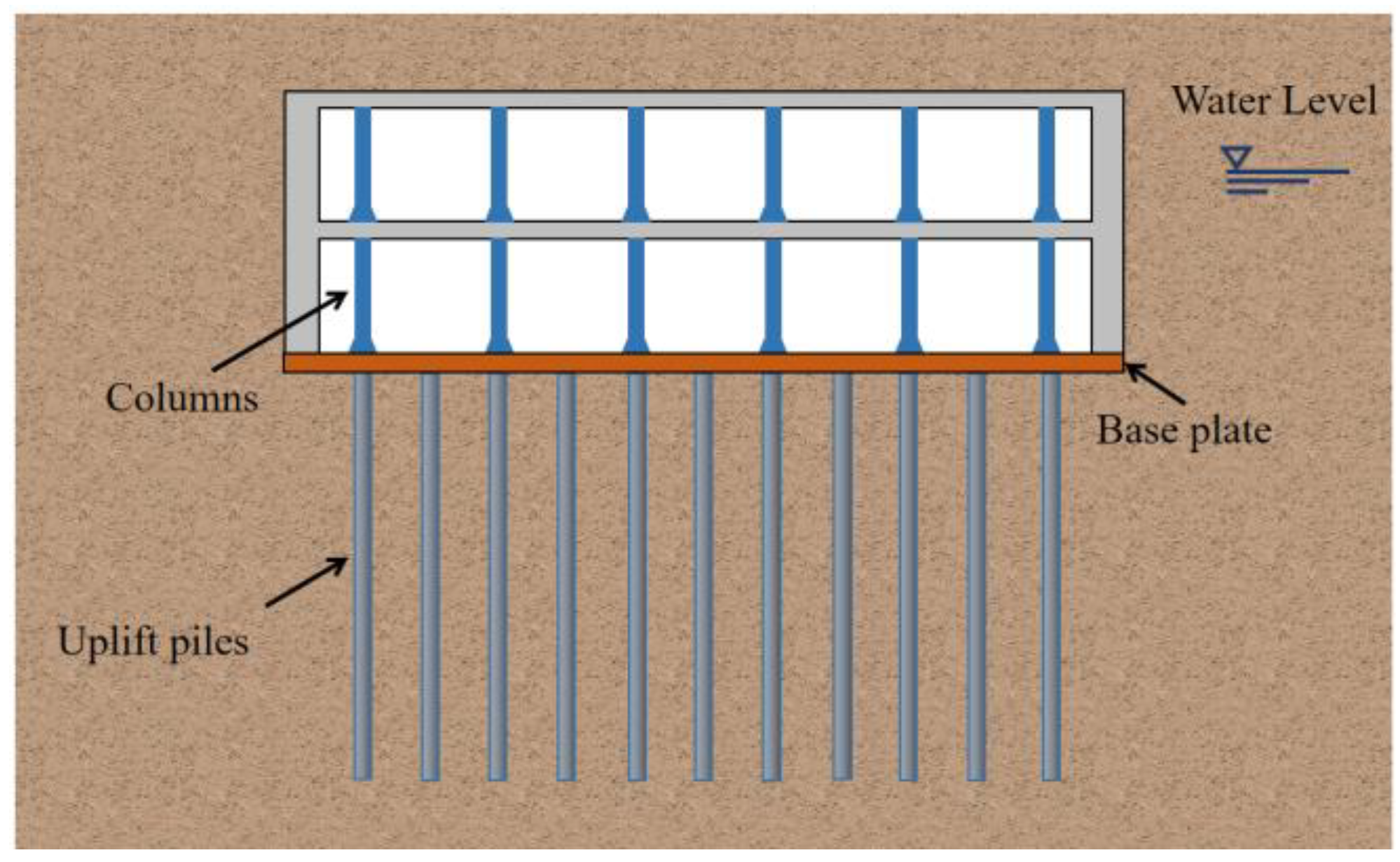

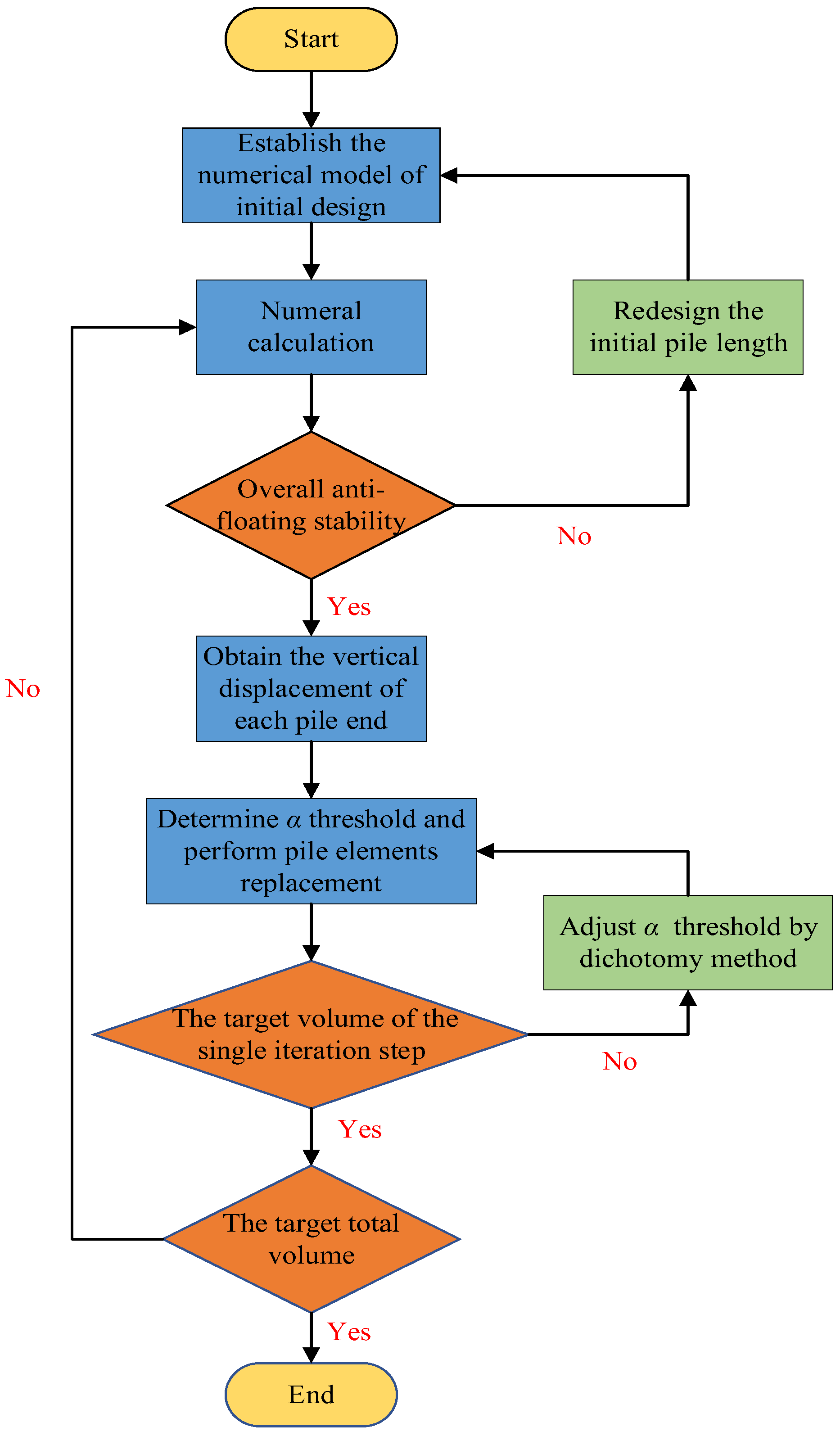


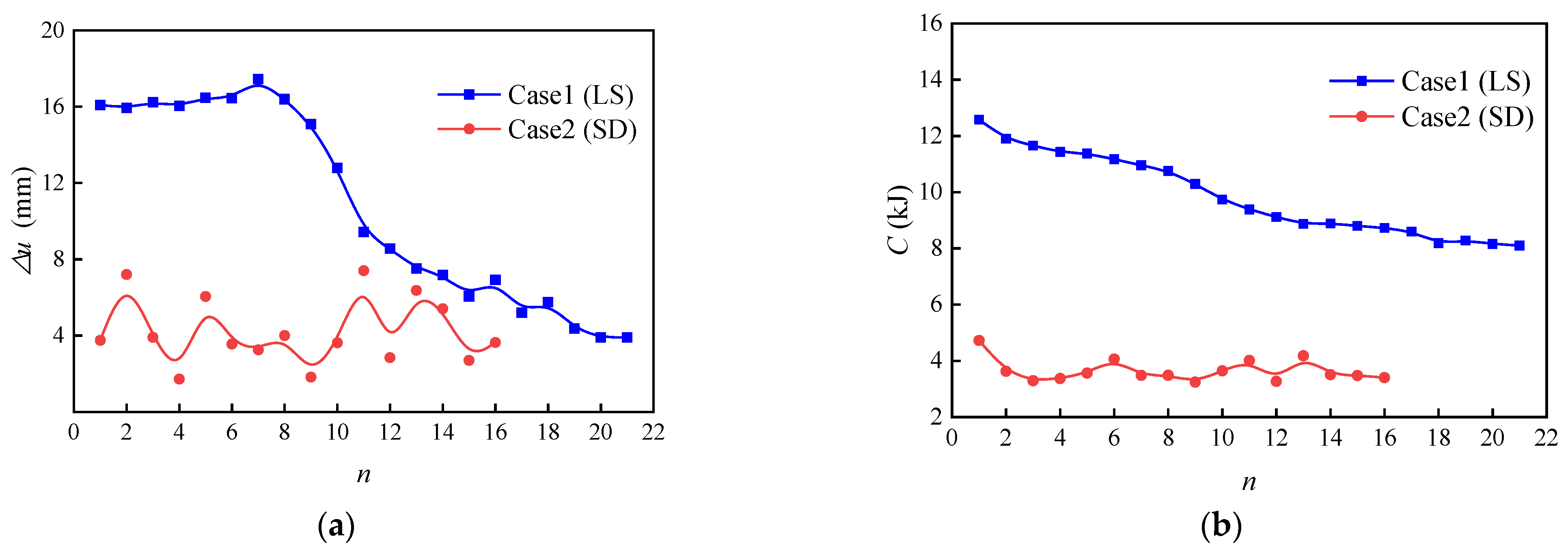


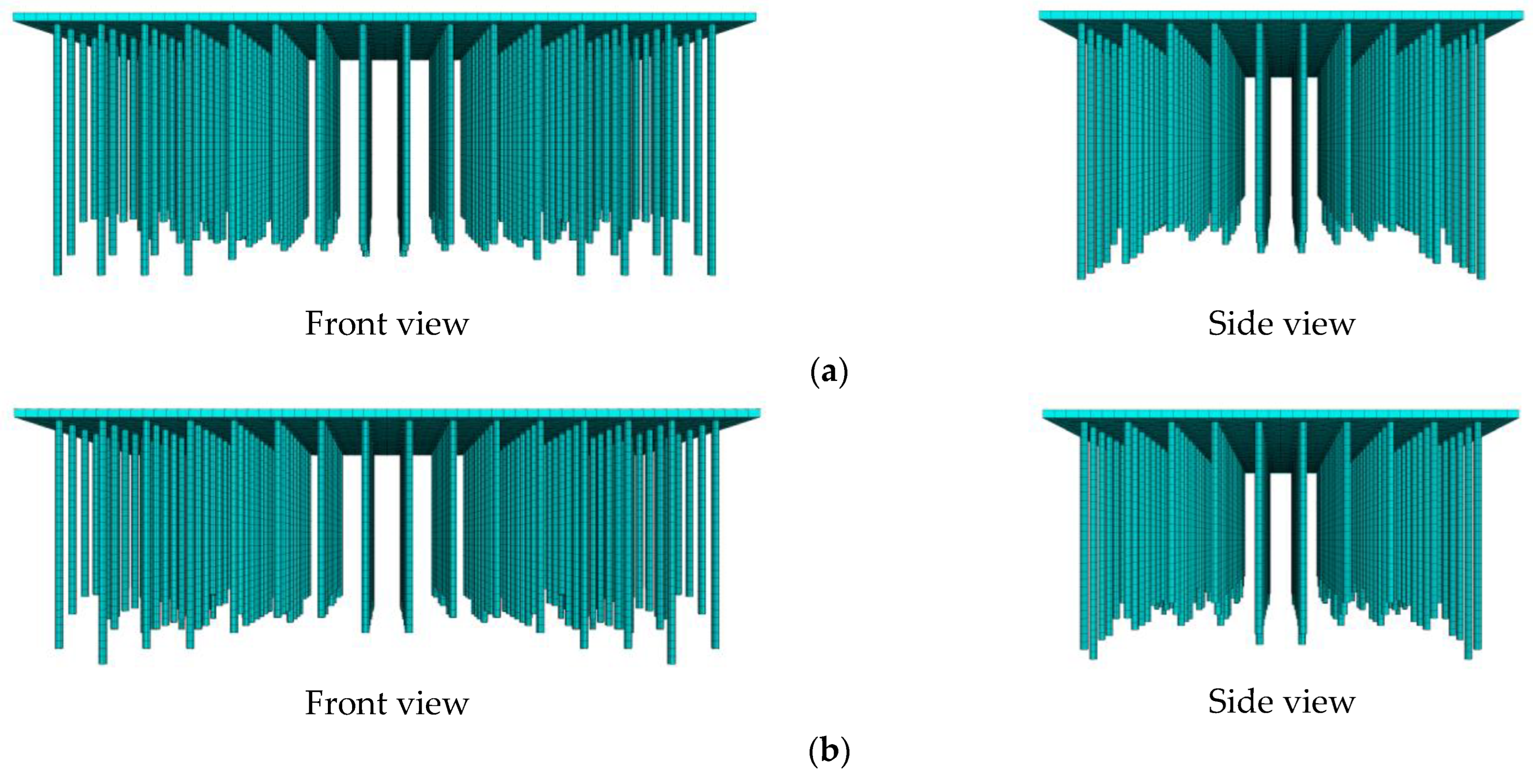
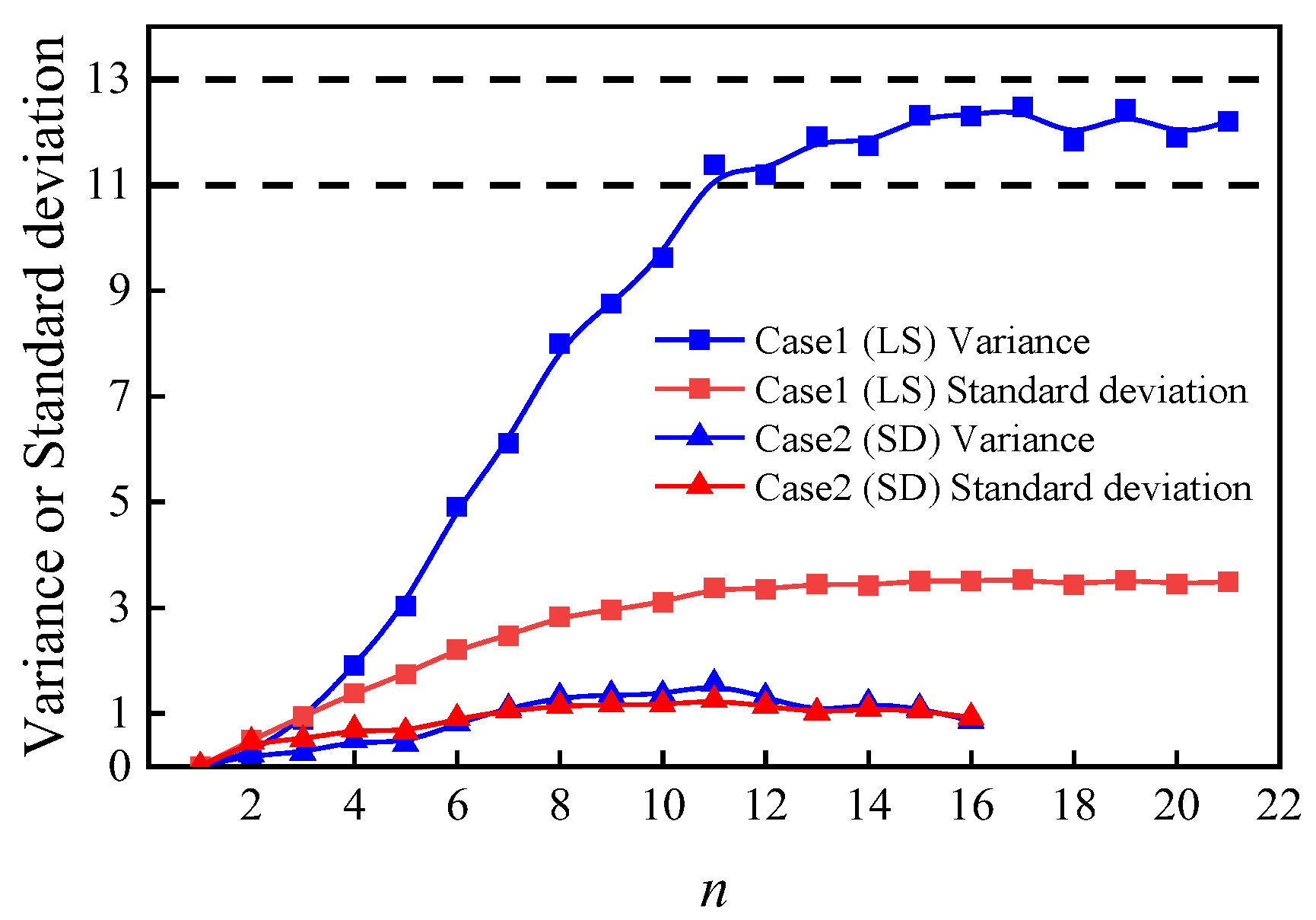

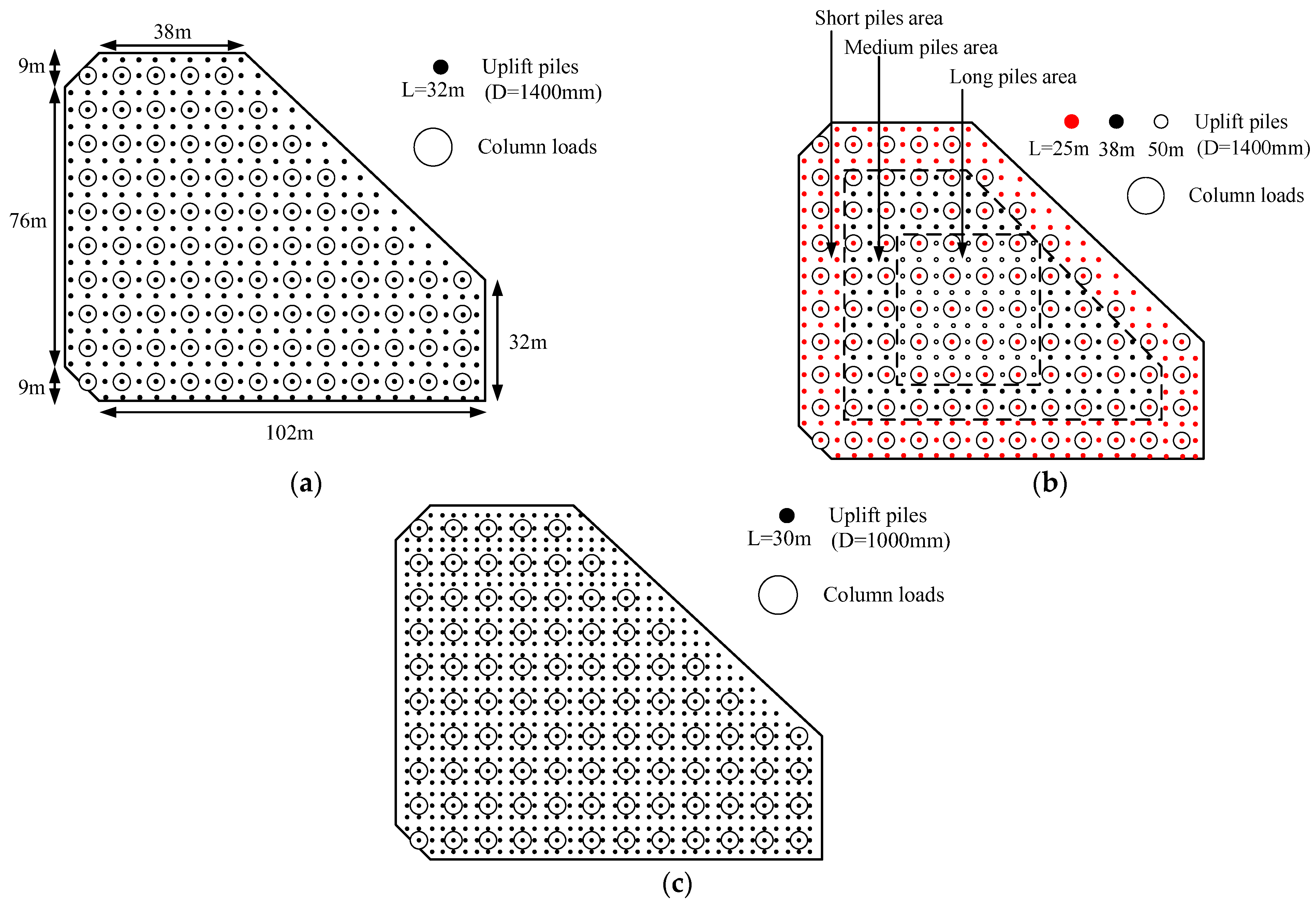
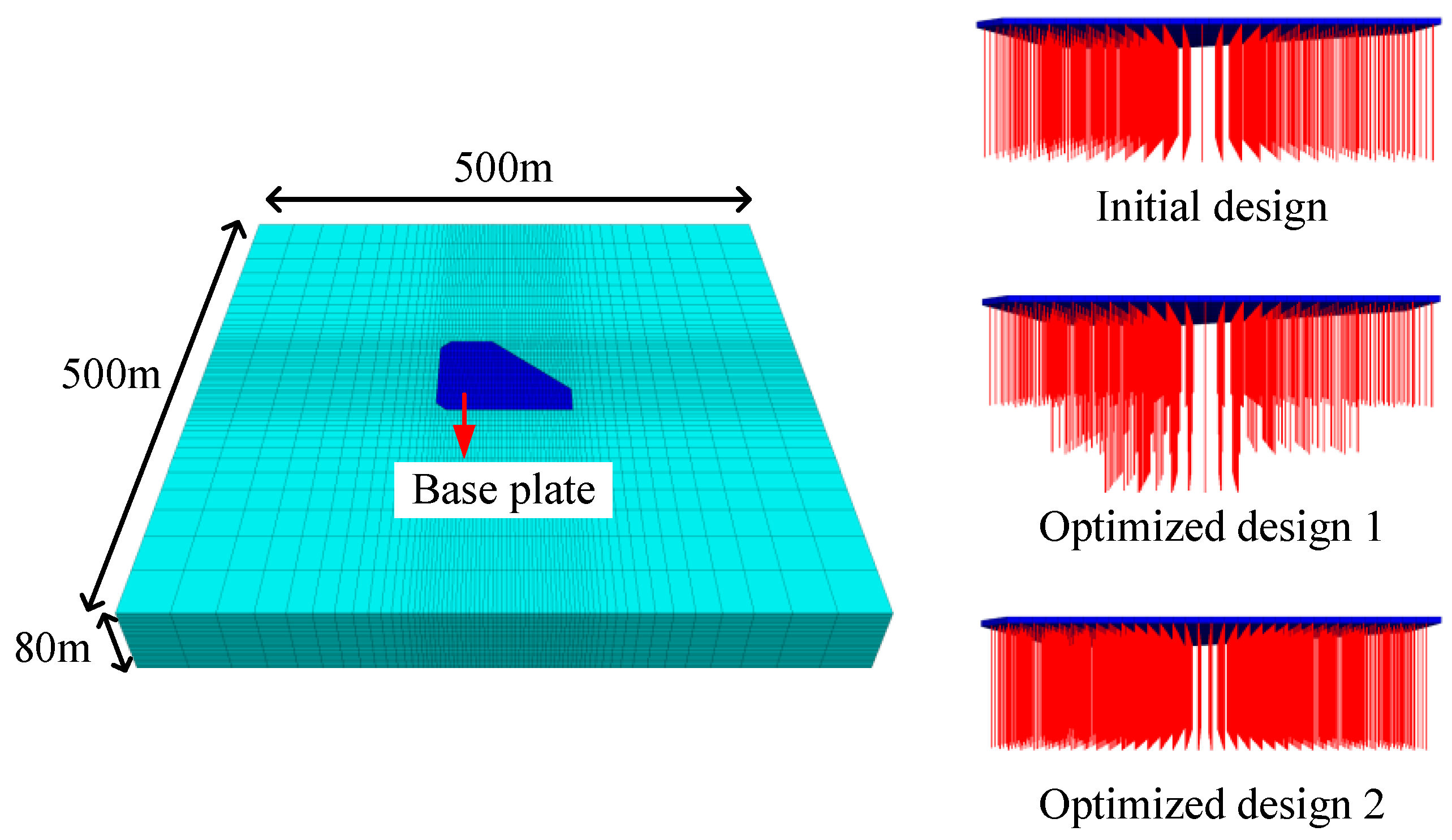
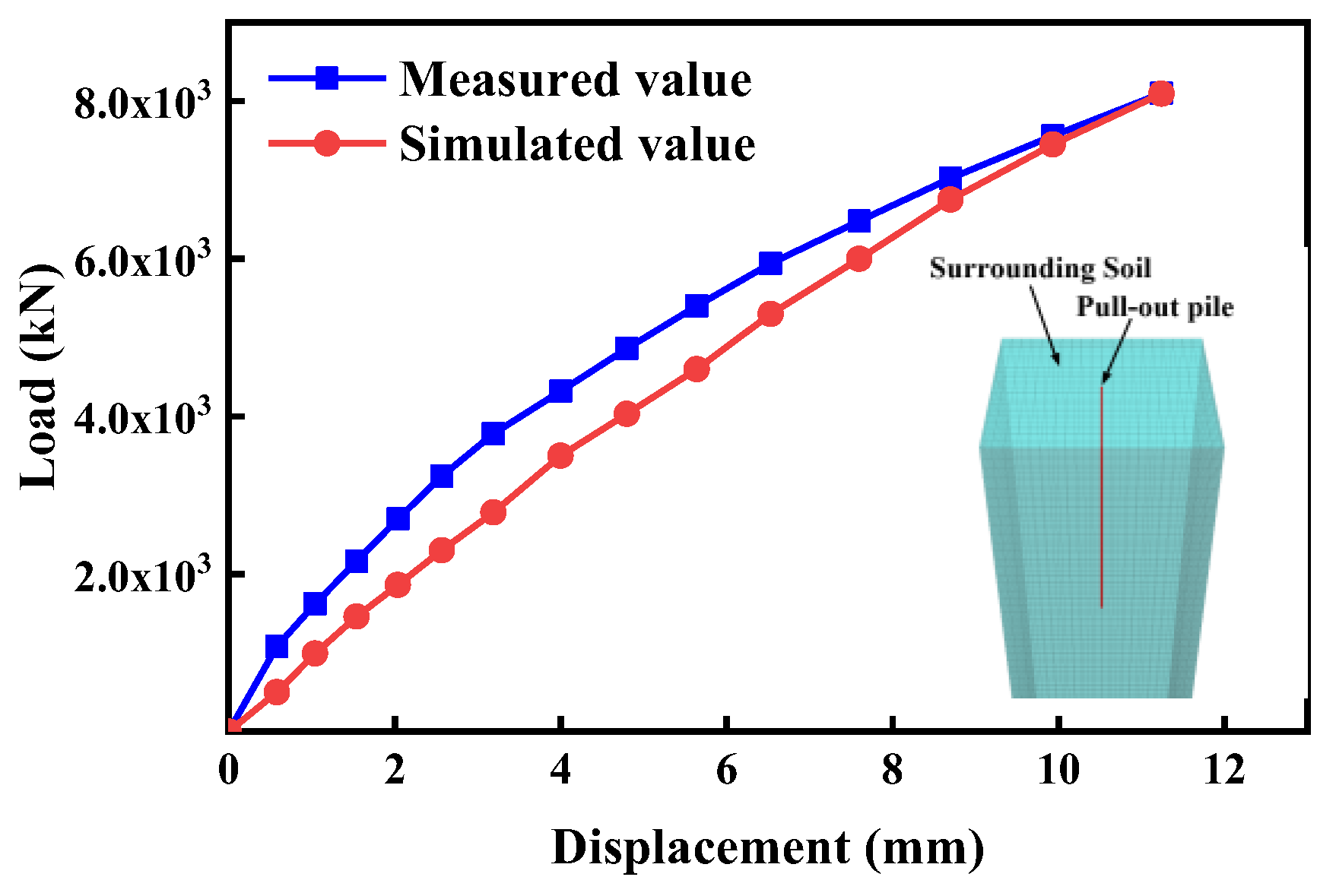

| Material Properties | Pile | Base Plate | Soil | Interface Element |
|---|---|---|---|---|
| Elastic modulus (GPa) | 25 | 25 | 0.1 | / |
| Poisson’s ratio | 0.2 | 0.2 | 0.3 | / |
| Friction angle (°) | / | / | 20 | 20 |
| Cohesion (kPa) | / | / | 30 | 30 |
| Tangential stiffness (kN/m) | / | / | / | 1 × 105 |
| Normal stiffness (kN/m) | / | / | / | 1 × 105 |
| Design | Pile Spacing (m) | Plie Diameter (mm) | Pile Length (m) | Column Spacing (m) |
|---|---|---|---|---|
| Original design | 4.5 | 1400 | 32 | 9 |
| Optimization design 1 | 4.5 | 1400 | 50, 38, 25 | 9 |
| Optimization design 2 | 3 | 1000 | 30 | 9 |
| Model Properties | Value |
|---|---|
| Length × Width × Height (m) | 500 × 500 × 80 |
| Young’s modulus of soil (GPa) | 0.13 |
| Poisson’s ratio of soil | 0.3 |
| Friction angle of the soil (°) | 20 |
| Cohesion of soil (kPa) | 30 |
| Hydraulic head (m) | 20 |
| Thickness of the base plate (m) | 1.5 |
| Bulk modulus of the base plate (GPa) | 13.9 |
| Shear modulus of the base plate (GPa) | 10.4 |
| Pile Element Properties | Value |
|---|---|
| Young’s modulus (GPa) | 60 |
| Poisson’s ratio | 0.3 |
| Tangential stiffness (KN/m) | 2 × 108 |
| Normal stiffness (KN/m) | 2 × 108 |
| Tangential friction angle (°) | 28 |
| Tangential cohesion (KPa) | 30 |
| Normal friction angle (°) | 0 |
| Normal cohesion (KPa) | 0 |
| Design | Maximum Uplift (mm) | Maximum Differential Deformation (mm) | Total Strain Energy (J) |
|---|---|---|---|
| Original design | 25.34 | 17.71 | 45,864 |
| Optimization design 1 | 16.63 | 7.83 | 37,039 |
| Optimization design 2 | 18.95 | 11.42 | 33,955 |
Disclaimer/Publisher’s Note: The statements, opinions and data contained in all publications are solely those of the individual author(s) and contributor(s) and not of MDPI and/or the editor(s). MDPI and/or the editor(s) disclaim responsibility for any injury to people or property resulting from any ideas, methods, instructions or products referred to in the content. |
© 2024 by the authors. Licensee MDPI, Basel, Switzerland. This article is an open access article distributed under the terms and conditions of the Creative Commons Attribution (CC BY) license (https://creativecommons.org/licenses/by/4.0/).
Share and Cite
Yang, M.; Wu, J.; Lu, Q.; Li, P. Optimization of Uplift Piles for a Base Plate Considering Local Anti-Floating Stability. Appl. Sci. 2024, 14, 5000. https://doi.org/10.3390/app14125000
Yang M, Wu J, Lu Q, Li P. Optimization of Uplift Piles for a Base Plate Considering Local Anti-Floating Stability. Applied Sciences. 2024; 14(12):5000. https://doi.org/10.3390/app14125000
Chicago/Turabian StyleYang, Meng, Jie Wu, Qianqian Lu, and Pengfei Li. 2024. "Optimization of Uplift Piles for a Base Plate Considering Local Anti-Floating Stability" Applied Sciences 14, no. 12: 5000. https://doi.org/10.3390/app14125000
APA StyleYang, M., Wu, J., Lu, Q., & Li, P. (2024). Optimization of Uplift Piles for a Base Plate Considering Local Anti-Floating Stability. Applied Sciences, 14(12), 5000. https://doi.org/10.3390/app14125000






